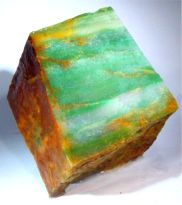| Greenlandite | |||
Greenlandite was discovered in
the 1960s during the survey of the large iron deposit, Isukasia
north of Nuuk. Greenlandite was subsequently discovered in
several localities in the Godhabsfjord area. It was later
established that the geological environment in which greenlandite
was formed was in the order of 3.8 billion years old. this means
that we are talking about one of the earths oldest formations
Geologically speaking, the rock consist of quartzite with a large content of a green minerals - fuchsite - evenly distributed throughout, giving the stone a fresh green color. Quartzite is made of fine-grained quartz, while the chromium-containing fuchsite resembles glitter, with fine spangles distributed throughout the rock. Greenlandite is a hard mineral, often translucent with a metallic inner glow derived from its many spangles. this type of stone is also known, in the jewelry trade, as aventurine quartz. Greenlandite has been used as a gemstone in Greenland for many years, justly marketed as “the world’s oldest gemstone”. Green aventurine quartz has long been known as an Indian or Brazilian gemstone, and more recently stones from southern Africa have appeared which can be difficult to distinguish from greenlandite. Experts will note that the color of greenlandite is a more bluish green than that of the foreign variants of aventurine quartz. Any confusion with jade (nephrite) (hardness H=6) can be resolved with a hardness test. Composition
Greenlandite is well suited to carving for signet rings, for example. the best-known use of greenlandite is in fact in the Bishop of Greenland’s cape. Larger pieces can be used decoratively as bookends or letter racks. It is also well-suited for use in larger stone arrangements, mosaics, and candle holders. MinerShop stocks an inventory of this and other Gem Rough. Contact sales for availability and prices. |


 Greenlandites’
two components are quartz (SiO2) with a hardness of H=7 and fuchsite
(K(Al,Cr)2AlSi3)10(OH,F)2) with a hardness of H=2.5. As a result
the stone is very hard and can readily be polished to a smooth
surface. Varying green (fuchsite) and white (quartz) schlieren
(streaks) in the same piece can produce many variants of the stone.
That indeed is part of greenlandites’ singularity.
Greenlandites’
two components are quartz (SiO2) with a hardness of H=7 and fuchsite
(K(Al,Cr)2AlSi3)10(OH,F)2) with a hardness of H=2.5. As a result
the stone is very hard and can readily be polished to a smooth
surface. Varying green (fuchsite) and white (quartz) schlieren
(streaks) in the same piece can produce many variants of the stone.
That indeed is part of greenlandites’ singularity. For
lapidary purposes the most usual form is as a cabochon, but flat
polishing also produces pleasing effects. Thin slices are partially
translucent, and are therefore well-suited to uses where light
can shine through them. Polished greenlandite is best suited
to mounting in silver. Superb results have been obtained by mounting
in combination with other single-colored gemstones, such as red
tugtupite, or blue lapis lazuli.
For
lapidary purposes the most usual form is as a cabochon, but flat
polishing also produces pleasing effects. Thin slices are partially
translucent, and are therefore well-suited to uses where light
can shine through them. Polished greenlandite is best suited
to mounting in silver. Superb results have been obtained by mounting
in combination with other single-colored gemstones, such as red
tugtupite, or blue lapis lazuli.